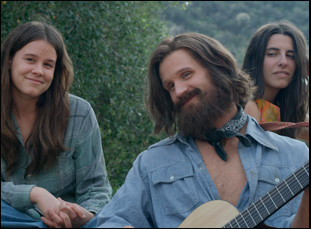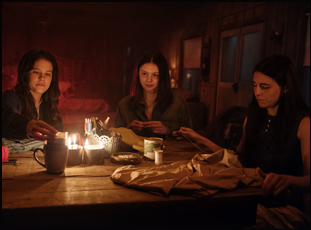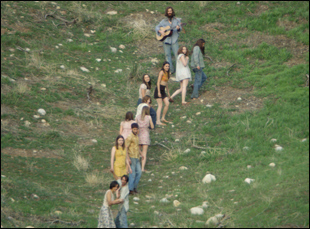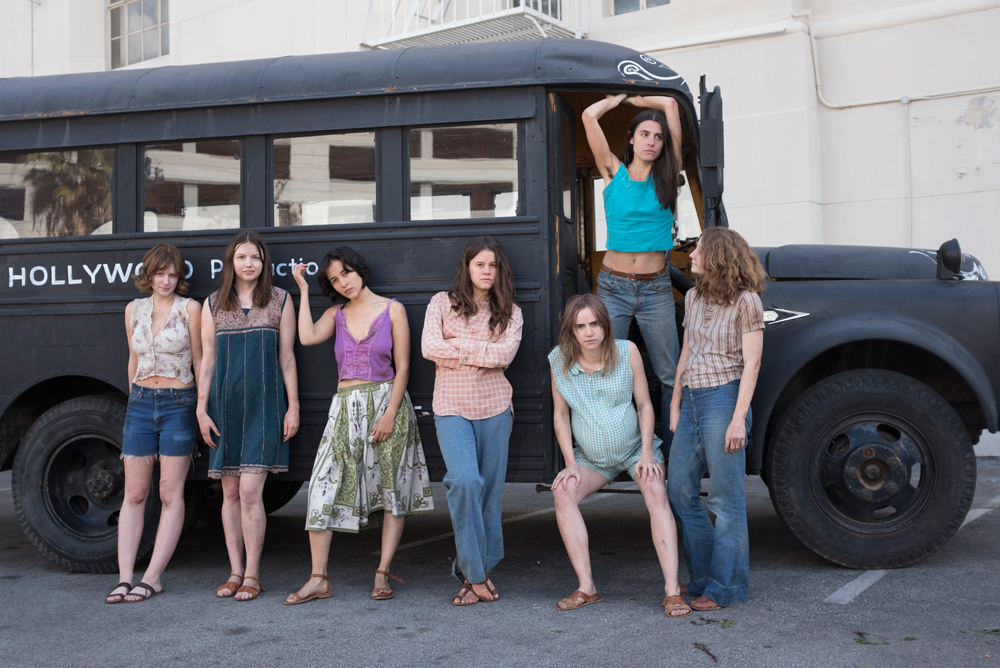“It’s very funny. When I was a very young journalist in New York, I did research for a writer who was doing something on Charles Manson… did I tell you this?” Mary Harron asks her creative collaborator for over two decades, Guinevere Turner, during a recent press day in New York.
“No,” Turner replied incredulously, having spent the last few years researching the infamous killer for their latest film “Charlie Says,” before turning to me. “Can you believe there’s something about Charles Manson that [Mary] has to tell me that we have not discussed?”
At this point, interviewing the filmmaking duo can feel like eavesdropping on a private conversation you’d be smart to just get out of the way of and record and as Harron shares how she unsuccessfully tried to get an interview with Manson at the behest of her boss while compiling fact sheets (“[I did learn from the warden] he was very interested in ecology — there was a big poster of whales on his prison wall”), you realize that the ability of these two to surprise one another is part of the enduring quality of their work when tackling history that they can always find an alternate angle on.
While the murderous trail of the Manson Family is by now well-worn territory for filmmakers – this year alone, the charismatic cult leader factors into Quentin Tarantino’s “Once Upon a Time in Hollywood” and season two of David Fincher’s “Mindhunter” – Harron and Turner provocatively shift their attention from the violent acts they committed to the trauma that happened within as young women lured to Spahn Ranch in California, where Manson (Matt Smith) made his home, with the promise of freedom and independence that they couldn’t possibly fathom as girls growing up in the conformist 1950s where they were expected to eventually take their place as a housewife.
But as with most things at the ranch, which was a popular spot for shooting movies, they didn’t realize it was an illusion as Manson played upon their desire to be a part of counterculture towards his own nefarious ends and it isn’t until three of the women – Leslie van Houten (Hannah Murray), Susan Atkins (Marianne Rendon) and Patricia Krenwinkel (Sosie Bacon) start reflecting on their experiences in prison with Karlene Faith (Merritt Wever), a UC Santa Cruz professor assigned to help with their education, that they can begin to process how exactly they began committing crimes and what may have felt like liberation was actually a jail well before they were put behind bars.
Following “I Shot Andy Warhol” and “The Notorious Bettie Page,” not to mention their adaptation of “American Psycho,” which has become such a part of the pop culture firmament that it feels as if it’s based on actual events, Harron and Turner’s ongoing restoration of the female perspective to history that’s largely been recounted by men, who have naturally placed themselves at the center of their own story, has been as enlightening as it has been invigorating, with “Charlie Says” becoming quite moving in how it gives its lead characters agency they haven’t been afforded before. Following a festival run that began last fall at the Venice Film Festival, “Charlie Says” arrives in theaters this week and Harron and Turner spoke about how it’s been in the works for some time, with the latter incorporating her personal experience of growing up in a cult into the script, and how a less sensationalized route into the story of Manson Family became such a sensational film.

Guinevere Turner: As the essay discusses, my personal story is a hard thing to write about, and when I first met with the producers to consider writing “Charlie Says,” I thought here is where my upbringing can really serve me in my work in a way that I’m not talking about my own experience, but I can bring a lot to the table that comes from a very real place. The reason I wrote the essay now is because I assumed that many journalists would Google me and see [this about my past], so I figured if I’m going to be talking about this, let me put it forth on my own terms. Did I expect that The New Yorker would say yes? Wow. That was amazing. I couldn’t have timed it the way it happened, but [when the producers] asked me to write this, I saw to bring stuff that I have wanted to talk about for my whole life.
Something that you mentioned in the essay that was interesting was this idea of an echo chamber of memory that I imagine becomes particularly intense in isolation – did that influence the film’s structure going back and forth between the prison and the ranch?
It’s an interesting question that I never really thought about, but I think that my own experience of deciding what to believe once I was no longer in the Lyman family really does inform their mindset. I feel I understood how you can stay believing a bunch of stuff that doesn’t quite make sense and struggling with that.
Mary Harron: …Stay in a world where you’re constantly being told things that don’t quite jive with your perception of the real world.
Mary, is it true you initially just read this as a friend, not with an eye to direct?
Mary Harron: That’s right. I’ve always been interested – I was a teenager during the late ‘60s, so I’m marked by that story the way that anybody was and I spent time in Los Angeles [then], so it’s a moment of my own memories of growing up, and I read “Helter Skelter” and all that stuff, but it was because Guinevere was writing it and because I had always thought it would be great for her to write something about her childhood [that] when she told me she was doing this story, I thought that’s perfect because without having to write something autobiographical as a film, I knew that she would have a take on it that no one else had and an understanding of the daily life of a commune. When I read the script, it was so clear that there was like an intuitive understanding of how someone like Manson kept control.

Guinevere Turner: I was so excited when I found that book. I was like, “This is an incredible story that no one ever talks about. They talk about the trials and the murders…” And we saw millions of interviews with Charlie in prison, but what about [the women]? When you find out about them, it’s like, “Oh, they got stuck for five years in this isolation?” And Karlene and I have a mutual friend, which is the only reason Karlene I think really trusted me because she wrote basically a book of advocacy for Leslie in the ‘90s, so people were approaching her for decades and she said, “No, no, no. I’m not interested in talking to you about your play or your movie. I just want Leslie to get off of parole.” But because we had a mutual friend, I said, “Can I just talk to you on the phone?” And then I gained her trust and we genuinely became friends. I went to visit her in Vancouver where she lived and I started to realize the more I talked to her that she was such a woman of her time.
A lot of the stuff that she was telling me about that had to do with her life was just really good texture for understanding how much the world had changed, so when we see them in the prison, how much the world had changed for women. You see these women who are trapped, frozen in time and she’s this budding, intense active feminist, and I thought, “Wow, this is going to be a great movie.”
I thought this fit into your shared filmography in an interesting way – from “I Shot Andy Warhol” on through “Notorious Bettie Page,” I’ve felt there’s this idea that men can retain power by giving women the illusion of freedom – is there anything to that?
Mary Harron: I don’t know if it’s part of the other films, but it was very much part of this and what I remember about the ‘60s, which is that there was lots of beautiful and wonderful things I can remember as a teenager, but as a young person, I didn’t fit into any of those female ideals and felt somewhat at odds with it because I knew I wasn’t an intuitive flower child or an earth mother – I didn’t want to just bake bread. There’s an element of this ‘60s counter culture where the male ideal is basically a rock star, whether you’re a cult leader or a political revolutionary, [where it’s] male sexuality and a certain swagger and the women are fans. That was the role that women had – fans or sexual partners or groupies – and it’s really interesting to me to look at the Manson story from that perspective.
Guinevere Turner: And the irony really that there’s this huge countercultural moment, but the gender roles were so old fashioned, exactly the same as the ‘50s.
Mary Harron: Yeah, they were remaking society and the plan was, “We’re going to tear up all social structures and the family unit’s gone because it’s outdated and oppressive, and we’re getting rid of the rules of morality,” and yet what we’re replacing it with is the idea of sexual freedom, which is the idea that women were free to have sex with anybody that they wanted, but basically they were considered repressed and uptight if they said no to anybody.
Guinevere Turner: It was damaging for a lot of women.
Mary Harron: Yeah, it was dangerous for a lot of women because they couldn’t say no or if they did say no, they were considered uptight. And a woman like Karlene Faith and the feminists of the early ‘70s are really women who had been through the radical movements and felt they were oppressed by the young men in those movements.

Mary Harron: Yeah, and it was actually easy to organize the shoot that way because we didn’t want to switch locations, but also when the girls went to prison – and we all went to prison for the last 10 days of the shoot – they had all the memory of the ranch behind them and that’s what they were drawing on. Their performance was about was them talking about those memories, which actually were memories.
Guinevere Turner: Yeah, we really were there covered in dust.
Mary Harron: And people had a lot of fun on the ranch, actually. Everyone bonded a lot, so there was a golden quality and then we were in this constricted prison set.
Guinevere Turner: In the dark. With no windows.
Since you mentioned “golden,” it appeared you were using natural light for the outdoors, which made it more intimate.
Mary Harron: Yeah, as much as possible. The night scenes, not so much. But Crille [Forsberg], the cinematographer and I, agreed that those scenes should have a golden sunset quality to it – as much like magic hour, even though magic hour is about this long [pinching fingers]. What we were filming were the girls’ memories of that time, which when they were in prison were kind of golden, but they get darker, so the interiors get redder and darker as time goes on.
If you’re moving timewise that way, are there any adaptations to the script you’re making for the prison based on what you’re seeing at the ranch?
Mary Harron: Nothing cataclysmic. There’s a lot of cutting before we started shooting, but also the meaning of what you’re doing really appears as you’re shooting in a way. It’s funny. You think it should all be obvious, but it’s not until the scenes come to life. And there were a couple scenes which our producer asked for, which at first I thought, “Why do we need this?” But I’m really so glad that we put in those scenes. Actually, one we didn’t [initially] have time to shoot. We added something.
Guinevere Turner: Right. And [Mary] wanted to add Karlene and Professor Bell walking into the prison…
Mary Harron: Yes, to talk about black power. Filmed that, introduced the black professor who comes in. We felt it was a bit abrupt just to cut to him, but also they have that little bit of conversation.
Guinevere Turner: Right, which I had written into the original script, which is him saying, “I just want to tell my wife I had met the Manson girls,” and she’s like, “Yeah, I get that too,” just getting that sense that everybody in the outside world was talking about them like they were these freaks.
Mary Harron: But the two scenes that we did as additional photography were scenes with Karlene’s group – her feminist colleagues – saying “Why are you spending time with these crazy murderer girls?”

Mary Harron: I certainly felt with “I Shot Andy Warhol” that [Valerie Solanas] was being rescued from obscurity. People had obviously published her manifesto, but that really was a story that no one had told – no one actually tried to tell her story, certainly not in a film. And when you consider the Manson story, these women aren’t just zombie extras, right? They aren’t just blank, smiling girls that are just a function of him that had no life and no history and no life outside of that moment. They had a past, they have a future and they never expected to end up in that place. So how did they get there? They didn’t start as murderers.
Guinevere Turner: So it really is about the side of the story that isn’t told or in Valerie Solanas’ case, not at all.
Mary Harron: And Susan Atkins wrote a book and Karlene wrote a book, but that’s not what’s focused on. That’s not the fascination of the culture. It’s really about Charlie. But to me, there’s not a lot of mystery in Charlie. Charlie’s a deformed, crazy person who was a danger to others.
Guinevere Turner: Right, because at the end of the day, it just feels like he’s this impulsive kind of creature who doesn’t really have any inner life. It’s just all about a need for power.
Mary Harron: But these were normal girls from backgrounds of different instability, different rates of security who ended up doing very, very abnormal things. How do people who do have a conscience and have empathy turn that off? That’s the mystery and the complicated question.
“Charlie Says” opens on May 10th in Los Angeles at the Monica Film Center, the Pasadena Playhouse, the NoHo 7 and the Laemmle Glendale and in New York at the IFC Center.




